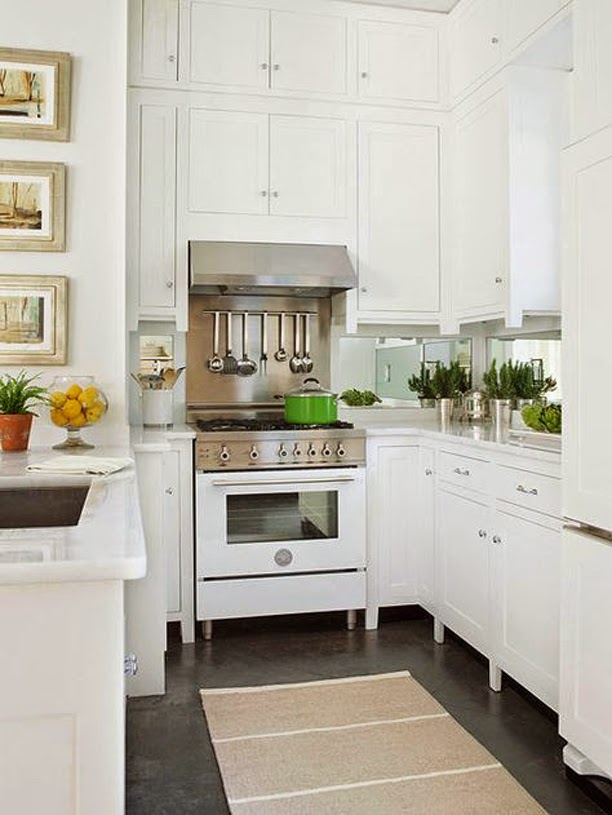Last week I shared a post I did for Jaime’s new website Postmodyrn about how to design with kids in mind. This week, I’m sharing another recent Postmod post I wrote about maximizing your small space:
The unfortunate part of living in a cool city like New York or San Francisco — or even living in the surrounding suburbs — is that you pay a high price for space. Often, we are stuck living in a space that works but isn’t our “dream home”, so to speak. So we make do with what we have. A question that I often get from friends and clients in high-rent areas is, “How do I make my space feel bigger?” Today I’m giving you a couple of tips I’ve learned along the way, and next month I’ll reveal a little more on how to make your small space feel larger.
Use appropriately scaled furniture: So much of the furniture out there these days is huge and overscaled. A giant sectional with huge roll arms might be great for the double-height suburban great room, but in a San Francisco high-rise condo or a 1927 cottage outside of New York, one has to be a little more concious of scale. The good news is that many brands such as Pottery Barn or Restoration Hardware are carrying “apartment-sized” furniture these days. Aside from seeking out items that are specifically labeled as apartment-sized, there are a few key things to look for, scale-wise. As mentioned above, large roll arms take up a huge amount of real estate but don’t increase the seating area on a sofa. Look for sofas that have tailored square arms, tight backs and are not quite as deep to maximize your floor space. Same goes for appropriately scaled coffee tables, dining furniture, etc. There is something trendy going on with bar-height tables, but they don’t work well for families (have you ever seen a high chair that works with a bar-height table?) and they take up a lot more visual space than a normal table. A large china cabinet might work in your parent’s formal dining room but consider a lower slung buffet that is open above so you can display some artwork and stage the top like a bar.
Tailored appropriately scaled furniture keeps this space from looking cramped. Source
Think of how you experience a space: Divide your space into zones even if you don’t have dedicated rooms. In my house you enter directly into my living room (my dream home one day has an entry foyer and a mud room). I especially hate this part of my house in the winter time when we have coats, boots and snow that gets tracked in. I was able to carve out a space in the living room that feels like an entry. How so? I delineated the space with a rug, and made sure there was a coat closet, a place to sit and a console for dropping sunglasses and keys. Similarly, in a small condo without a separate dining area, carve out a dining space behind a sofa or in a corner. Often times a bench or banquette tucked up against a wall works better than using chairs around all sides of a table because it allows the table to sit closer to the wall (because you don’t need the space to pull a chair out).
In my own home, we’ve created an entry space in the living room.
Use furniture that does double duty: In a small space, double duty is a key word (or words). Use an ottoman with a tray on top of it instead of a coffee table. This works as a footrest, storage (if you have a storage ottoman), and is much more child-friendly than a table with sharp corners. In carving out spaces within a room as per the above recommendation, consider a bench or day bed between two spaces. It doesn’t block the view, adds seating, and can even function as a guest bed in a pinch. Places like West Elm have a slew of small cocktail tables that can double as stools for seating and tuck nicely under consoles and next to sofas.
Storage ottomans along with mirrored frames add space to stash stuff and bounce light around. Source
Use Mirrors: I’m not saying that you should turn your home into a Vegas lounge — no mirrored ceilings please! But it’s true that mirrors expand the view and double the feeling of space. Consider mirroring your kitchen backsplash (mirror is a low maintenance surface, easy to clean as a backsplash and allows you to see the party when you’re facing the wall chopping crudites). Adding a piece of mirrored furniture gives a touch of sparkle and doesn’t feel as heavy as its wood alternative (although please don’t buy the entire mirrored bedroom suite). And strategically placing a mirror so that it reflects a view of the outdoors is a great way to make a space feel airy and open.
A mirrored back splash expands this tiny kitchen. Source
Stay tuned for more space expanding tips in next week’s Postmod post.



